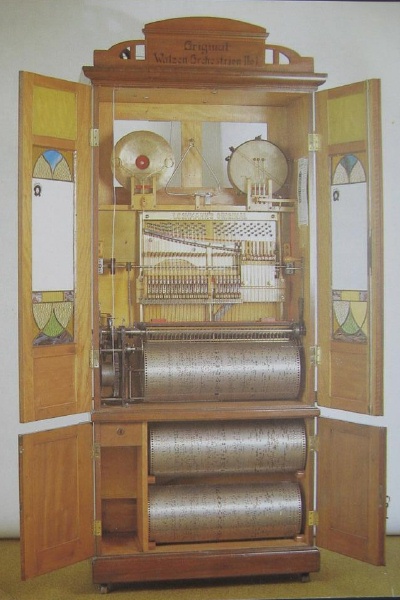
Doctor Peter Henri Van Der Weyde was born in Nymegen, Holland in 1813. He went on to live a remarkable life of achievement in the sciences and the arts. He died in America in 1895.
While serving as editor of Manufacturer and Builder Magazine, he wrote many articles, including the ones which gave this blog its name. In 1893 and 1894, he published a 23-part (!) memoir in the same periodical. Here is the nineteenth part. He continues to talk about his interest in music.
Elias P. Needham was an American inventor who created programmable musical devices which led to the player piano.
An orchestrion is a mechanical device that plays music on more than one instrument. The image is a postcard view of a Waltzen Orchestrion.
I can't identify Mr Gally (Galli?) as an orchestrion-maker.
Part One
Part Two
Part Three
Part Four
Part Five
Part Six
Part Seven
Part Eight
Part Nine
Part Ten
Part Eleven
Part Twelve
Part Thirteen
Part Fourteen
Part Fifteen
Part Sixteen
Part Seventeen
Part Eighteen
Reminiscences of an Active Life.
BY DR. P. H. VAN DER WEYDE.
From Manufacturer and Builder, Volume 26, Issue 8, August 1894
9th. Career as a Musician.-- It is a pleasant recollection to me that I have contributed my mite to the development of the orchestrion, by demonstrating practically the capacities of the systems of perforated papers as a substitute for the barrels, by boldly taking such a step as to make, by such means, the execution of one of Beethoven’s masterpieces possible, and this even on such small instruments as those made by Mr. Needham.
A serious drawback, however, soon presented itself. It was that the holes had to be of quite large size, in order to admit wind enough for sounding the reeds. These large holes took much of the strength of the paper away, and the tearing up and rapid deterioration of them, when frequently used, was the inevitable result.
The correction of this defect was an example of the desirability that more than one mind should occupy itself with inventing improvements. The most important improvement was the balanced valves, of which one half moves against the air pressure and the other half with the air pressure, because the axis upon which it turns is made at the middle of the valve, so that only a small spring is needed to keep it closed, and very little power is required to open it.
The next invention was the pneumatic motion which opens quite a large valve by the pressure of the air passing through a very small hole in the paper. This reduced at once the size of the paper, from the length of 50 feet and width of 2 feet, to 20 inches in length and 3 inches in width, and made it possible to use a small round punch, making a series of holes, of which the effect was equivalent to the large hole.
Such organs are now successfully made in Germany, of which a fair specimen can be seen in the Atlantic Garden, New York, where they have a repetoire (sic – JT) of some 200 different compositions represented by 200 little sheets of paper, each of which, when placed in the organ, will cause the performance of, say Wagner’s Tannhaeuser overture, in all its details.
We are happy to state that such organs are now made in more than one city of the United States.
Foremost among those who, in the United States, have made themselves meritorious in the improvements in the methods of producing music automatically, stands Mr. Gally, who had previously distinguished himself in the manufacture of improved printing presses.
As he holds an eminent position in this branch, having been foremost in its improvement, we will in our next devote to his improvements in this line a separate article.







No comments:
Post a Comment